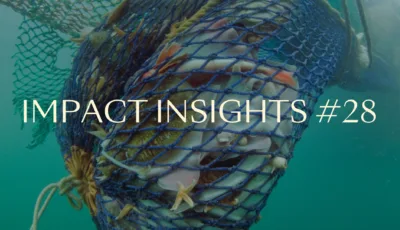Impact Insights #3

With so much happening in the world of impact and sustainability, it can be challenging to stay on top of the latest trends and developments. That's why our impact team has put together Impact Insights. A monthly series to help you stay informed and ahead of the curve. So sit back, relax, and get ready to expand your knowledge on the latest impact and sustainability news from March.
Curated by Norselab's former Sustainability Strategist, Åsne Burgess Øyehaug.
■From framework for action on nature.
March 3rd was World Wildlife Day. What better way to celebrate this occasion than to bring you news worthy of cautious excitement. Following the agreement on a Global Biodiversity Framework at COP15 (“Conference of the Parties''; the formal meeting of the parties in the Convention on Biological Diversity (CBD)) in Montreal, there are at least two hopeful tracks for large-scale corporate action.
The Science Based Targets Network (SBTN) has been working on new guidance to set land science-based targets. The guidance is currently open for public consultation, a good indication that progress being made to finalize a first version soon. The guidance will direct companies in assessing, avoiding, or mitigating their impacts on nature, and will also incentivize companies to deliver regenerative, restorative, and transformative actions for the sustainable development of land and nature. The guidance is based on the same approach as the Science Based Target initiative (SBTi) for corporate climate targets. Being the leading net-zero target initiative for companies serious about their climate action plan, this is promising for the next land science-based targets.
A Taskforce on Nature-related Financial Disclosures (TFND) is also set to release an updated beta version this month. The TNFD framework builds on the Taskforce on Climate-related Financial Disclosures (TCFD), the leading framework for reporting climate risks. By the end of the year, we may therefore have firm, voluntary standards for setting targets and for reporting on nature impact based on well-known frameworks for companies.
■A deal for the ocean.
An international treaty to protect international waters was reached earlier this month. Almost two-thirds of the ocean lie outside national territorial waters. The new treaty will provide a legal framework for marine protected areas (MPAs) to protect against the loss of wildlife and genetic resources. A dedicated conference of the parties (COP) that will meet periodically was also established for states to be held accountable. The treaty is necessary to reach the target to protect 30% of the ocean in the Global Biodiversity Framework at COP15. We would not be surprised to see the new treaty referenced in the TFND explained above, and future target-setting guidance for the oceans and waters.
■Labeling and naming confusion: The Sustainable Finance Disclosure Regulation (SFDR) has come into full force in 2023.
SFDR requires financial market participants such as investors to publish information about the sustainability performance of their investments if they fall within “Article 8” (“light-green funds”; funds promoting sustainability characteristics) or “Article 9” (“dark-green funds”; funds with a sustainable investment objective). However, the SFDR’s definitions of Article 8 and 9 remain vague and fail to set clear sustainability thresholds for Article 8 or 9.
In an attempt to reduce greenwashing, the EU’s financial markets “watchdog”, the European Securities and Markets Authority (ESMA), released a proposal last year to define which funds can include terms such as “ESG” or “sustainable” in their names and recommended sustainability thresholds for Article 8 and 9 funds. The challenge is that the ESMA guidelines conflict with the SFDR definitions for Article 8 and 9, creating confusion for investors, markets, and customers.
The consultation for ESMA’s proposal closed in February, and the backlash has been considerable. At Norselab we believe that it’s more urgent to clarify is the definition of “sustainable investments” under the SFDR, rather than introducing new thresholds for naming. There would be less confusion with more clarity on e.g., how to define investment objectives in line with “sustainable investments” and how to measure those objectives. This is also the position of EFAMA (European Fund and Asset Management Association) and GIIN (Global Impact Investing Network). GIIN told Impact Investor: “What is more important than naming, in our opinion, is that funds are expected to articulate their intended impact objectives, how they seek to achieve those objectives, and their methodology to measure and manage their impact performance.”
■ESG meets politics in the US.
Across the pond, ESG has become something of a political debacle. Several states are debating a ban (and some states, like Florida, already put in place such a ban last year) on using ESG factors in pension funds’ investment decisions. The ‘anti-ESG’ movement is largely led by US Republicans, arguing that ESG is ‘political’ and that retirement savings for millions of people are jeopardized for the sake of politics.
Most US Democrats argue that ESG is material to investment risk management and it’s therefore the fiduciary responsibility of pension funds to include ESG factors. The tensions peaked again this month when President Biden vetoed a congressional resolution trying to stop an ESG rule for the Department of Labor (the department governs the rules for certain employer pension funds). Interestingly, this ESG criticism could boost impact investing: Maria argued in a new article earlier this month that despite the ESG criticism, “We’re seeing investors really wanting to support companies that have products that are good for the planet or good for people.”
■Green bonds agreement EU.
In the EU, a provisional agreement for ‘EU Green Bonds’ has been reached by the Council and the European Parliament. The next step is for the agreement text to be formally approved and entered into law (a formality). The agreement puts the EU Taxonomy front and center: all proceeds from an EU Green Bond must be invested in activities aligned with the EU Taxonomy. There will be some flexibility to activities that are not covered by the EU Taxonomy. Currently, only climate is covered under the EU Taxonomy. For the bond to be truly ‘green’ by addressing a range of environmental issues such as circularity, pollution, biodiversity, etc. in addition to climate, the technical criteria for the remaining four environmental objectives in the EU Taxonomy will need to be approved.
Sign up to our newsletter to get the next Norselab Impact Insights straight into your inbox.


